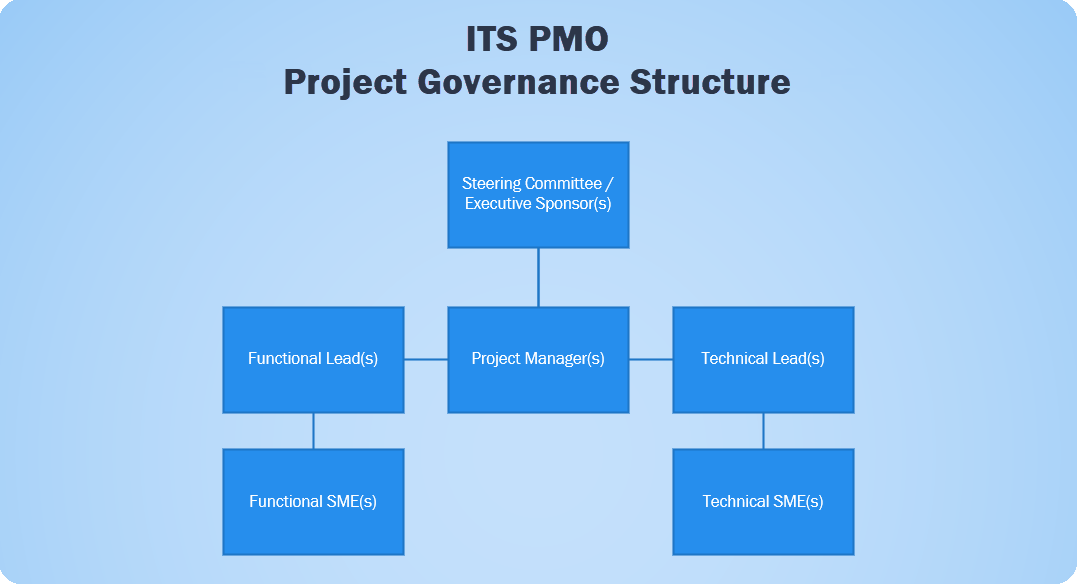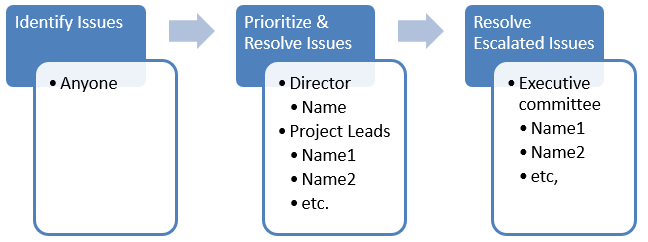
What is Project Governance?
Project governance provides guidance and oversight for project management activities to deliver a product, service, or result. It is a crucial component of the ITS PMO, serving as a strategic framework that ensures projects align with the university’s objectives. It is central to maintaining control over project outcomes, managing risks, and ensuring compliance with relevant standards and regulations.
In its simplest terms, project governance is the practice of ensuring that the project does all the right things and does them in the right way. It is a critical element and the framework of all our projects.
The ITS PMO uses this simple governance structure that allows for easy adoption by team members and all types and sizes of projects. This simplified structure also provides clear accountability, allows faster decision-making, and prevents unnecessary bureaucracy.

Why Should We Care?
Although we have always followed project governance in our larger projects, we never officially clarified it in writing. Here are some reasons we need to care about project governance in all our projects - large or small.
- Alignment with the University’s Goals: Effective governance ensures that every project decision and outcome supports broader business objectives, helping project managers align their efforts with the university’s strategic direction.
- Risk and Compliance Management: Governance frameworks help identify, evaluate, and mitigate risks while ensuring projects comply with relevant laws and regulations, thus safeguarding the university and enhancing project success.
- Resource Optimization: By adhering to governance standards, project managers can optimize the use of resources, avoid overruns, and manage project budgets more effectively.
- Enhanced Communication and Reporting: Governance structures provide better communication channels and reporting mechanisms across projects, improving stakeholder engagement and transparency.
- Support and Escalation Pathways: Governance provides a clear path for escalation and support, which is crucial for resolving issues beyond the project manager's control, and ensuring continuous project advancement.
Tailoring Governance to Project Needs
We know that project governance is not a “one-size-fits-all” type of structure. The depth and intensity of governance involvement will vary depending on the project's size, complexity, and strategic importance. Larger or more critical projects may see more intensive governance activities, while smaller projects might interact with governance bodies less frequently.
This tailoring ensures that governance efforts are proportional to project needs without becoming overly burdensome or restrictive, thereby maintaining efficiency and adaptability across the university’s project portfolio.
What is the Process?
We will meet with you at the beginning of your project to gather the project specifics. We can usually determine the level of governance needed from this first meeting. We start by completing the Project Intake Document which acts as a charter for the project. Here are the basic steps.

- Define the project's purpose, goals, and scope.
- Determine the key stakeholders for a project and the modes of communication.
- Define the proposed solution and what success looks like based on project leadership, technology, internal teams, and dependencies. This step focuses on defining stakeholder engagements and involvement.
- Determine the escalation path when issues arise. If necessary, complete the Project Governance Template, which is a one-page document outlining the escalation path, shown below.
- Define the project's requirements and the nature of the project based on the tempo and pace.
The ITS PMO provides guidelines for managing the planning, stakeholders, and kick-off meetings. And, for departments that want to manage the project themselves, we will provide templates for reporting, communications, lessons learned, and project closure.
Get access to all of our project templates here.
Issue Management
As stated above, the governance structure outlines the escalation path for issue resolution. Each project team will define at which level decisions are made. For example, if there is a major change in scope, schedule, or budget, the Executive Committee or Project Sponsor could make these decisions. You will want to identify each level's decision-making power.
As more questions arise, the Directors will strive to agree on the resolutions. If the issue cannot be resolved at the Director level, it will be escalated to the Executive level. This escalation decision can be recorded in the Project Governance Template as shown here.
